Hellgrammites, Green Frogs
and Other New Hampshire
Fishing Methods of Master Angler,
Harold (Hal) C. Lyon, Jr.
Stories Using Hellgrammites for Catching Bass
in Lake Winnipesaukee, New HampshirePart 2
 Fishing stories and techniques:
Fishing stories and techniques: 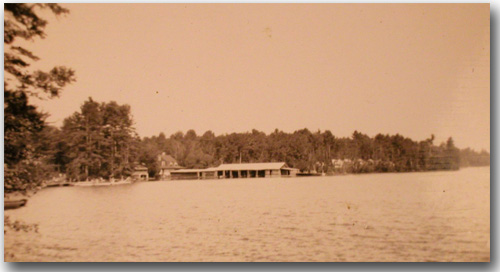 My uncle had an ongoing rivalry with Shep Brown, owner of Brown’s Boat Basin on Meredith Neck in New Hampshire, for big bass. I recall Uncle Gordon, in his white "Laker" boat "PUT-PUTTIN" across the lake toward home with a granddaddy 5-pound bass attached to his stringer with hellgrammites, stopping every few minutes to keep the monster revived, just so he could show it off to Shep Brown, before releasing it.
My uncle had an ongoing rivalry with Shep Brown, owner of Brown’s Boat Basin on Meredith Neck in New Hampshire, for big bass. I recall Uncle Gordon, in his white "Laker" boat "PUT-PUTTIN" across the lake toward home with a granddaddy 5-pound bass attached to his stringer with hellgrammites, stopping every few minutes to keep the monster revived, just so he could show it off to Shep Brown, before releasing it.
Bragging may not bring about happiness, but no angler, having caught a trophy fish, sneaks home quietly with it! These monsters would invariably live with dignity under Brown's Boat Basin docks where I would ardently fish using hellgrammites, hoping to hook one of these giants.
I recall once when I was ten or eleven, hooking into "Ol' Methuselah," a giant, bass who was often seen from Brown's dock, but never caught. As he took off on his second run on one of my dead hellgrammites (the price of hellgrammites being what they were, Gordon allowed us to use only his dead ones), I couldn't feed out line fast enough.
He just kept running toward Bear Island …and never stopped. My line broke when it ran out and there was no stopping him. Everyone suspected that the fish, which hung around under the docks, were bass released by my Uncle Gordon and they were probably right!
In the late 1940‘s when I was a teenager working in summer pumping gas at Brown's, I had the opportunity to scuba dive beneath the docks. I was awed, and a bit frightened, by the huge bass, swimming fearlessly toward me, opening and closing their huge mouths, like bullies, warning me that I was in their turf. Watching my uncle was my first experience of seeing the practice of using hellgrammites for catch and release of the bass, and I knew of no others using doing this with hellgrammites at that time. Everyone we knew, was practicing catch-and-eat back then.
Letting bass run before setting the hook was an important bit of angling knowledge Uncle Gordon passed on to me. If you set the hook as soon as the bass takes one of your hellgrammites as bait, as many children and some tourists do, 8 times out of 10, you would lose him. Later we were to discover more about this process as well as the discovery of diving down to stir up their anger, curiosity, or appetites for the hellgrammites or other bait.
One late afternoon in July in the 1960s, I was fishing in New Hampshire with my sons, Eric and Gregg, then 7 and 6 years old. The fish weren't feeding and I put on my mask and flippers and noisily jumped overboard. After swimming around the rocks we had just been fishing while using hellgrammites, I spotted two huge bass, just off the side of a large ledge.
They curiously eyed me from a distance of about ten feet. Bass are not afraid if you're under the water with them. This is what makes them so vulnerable to the illegal spear fishermen, who sometimes poach them in Lake Winni. It's a sacrilege to shoot a spear into the side of a beautiful bass and haul him in half dead with a heavy cord, when the fish could give such a noble fight on a light line with hellgrammites as bait.
I surfaced and hollered to Eric to cast out a frog instead of using hellgrammites. We used small green frogs when we could get them. We hooked them through the thigh with a # 1 hook and no weight, so they swam freely on the surface.
Eric let fly with the frog. The frog splashed several yards from me and began to kick around on the surface. One of the bass took off from his lair 15 feet below the surface, like a rocket, toward the frog! Never stopping, he engulfed the frog with a splash, and took off on a deliberate run toward open water, away from smaller, bothersome fish, to savor his dinner.
I followed with mask and flippers as Eric fed him slack line, to run unimpeded. I noticed that the bass carried the frog by one leg, almost daintily in his lips. After running about 10 yards toward deeper water, I watched the bass stop, spit out the frog, and then gulp it down headfirst.
He took off on a second, faster run, this time visibly opening his mouth, presumably to allow the force of the water to flush the frog deep down into his stomach.
On this second run, Eric set the hook. The unique spectacle of watching a 4-pound bass from under water was not only instructive, but exciting. To watch from under water, while the big bruiser raced toward the surface and disappeared, as he jumped, was a rare sight!
That same year, I watched from under water as my sons caught other bass on hellgrammites, crawfish and frogs. All these fish were deeply hooked.
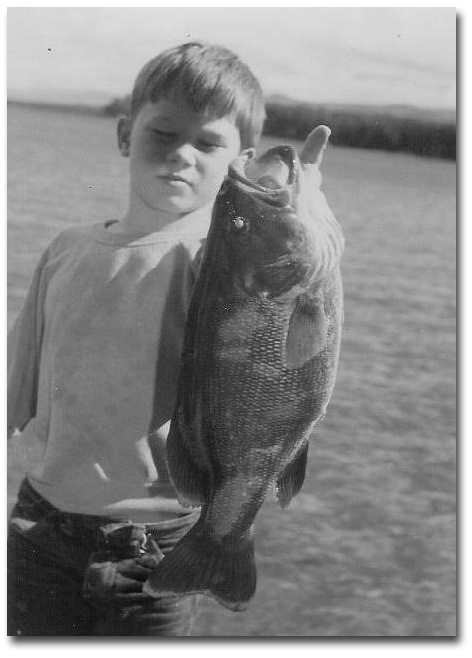
Whenever we accidentally set the hook too early, before the second run, in most cases, the hellgrammites were pulled from the bass' lips. Only on rare occasions would we lip hook and land such a bass. Needless to say, with a fly or other artificial lure, one does not have this problem as the fish strikes the lure and is either instantly hooked or missed.
That same year, at age 7, my son, Eric, caught a bass on a live frog in that same spot which won a first prize gold badge in the Junior Division of the Field & Stream Magazine fishing contest. Two years later, my son, Gregg, at age eight caught its identical match, pound for pound.
Catching Them on the New Hampshire Beds in Spring TimeSome of the other Master Anglers only go for bass in the spring spawning season when they are "on the beds." They are very easy to catch then, attacking any lure and hellgrammites which comes near their spawning bed.
I enjoy going out in a canoe with my fly rod and a bass bug or hellgrammites and casting into shore and their beds in early June. The spawning season usually runs from mid May to June 15, and is triggered when the water reaches 59º.
The male is the star of this activity, doing most of the work. Males come into water 2-10 feet deep and, with their tails, sweep clean a sandy bed from 2-4 feet (depending on the size of the bass.) Loyally, the male guards the nest until the female, fat with eggs, appears for a few brief minutes, laying her eggs onto which he deposits a cloud of milt (sperm).
She is then finished with the entire process, never to see her young again -- the inverse of what occurs with us humans! The male faithfully guards the eggs from hungry predator fish -- sunfish, horned pout, and perch.
When the eggs hatch 8-10 days later, depending on water temperature, he carefully guards the fry from predators and attacks anything that comes near the bed including lures, flies, or swimmers. On several occasions, I have had them charge and attack me – courageous fathers! The male remains with the bed for another week until the small fry make their way from the nest into the shallows and rocks to fend for themselves.
Fishing for bass using hellgrammites on the "beds" in spring is definitely a catch and release time. Not only is it illegal to keep them then, but if you take a bass off of a bed, you may be preventing the opportunity for a thousand new bass fry to begin their lives. You may legally keep 2 bass from June 15--July 1, when the limit becomes 4. Still, I prefer to carefully release them to return to their beds.
A Numbered Brick Study
The New Hampshire Fish and Game biologists did an interesting study using University of New Hampshire students to help. They placed numbered bricks along a hundred visible sandy bass spawning beds.
They waited until the bass had completed their spawning ritual and then caught the male bass from each of the beds. Half were immediately released and returned to guard their beds; the other half were transported a half mile away and then released. The numbered beds were observed daily.
Very few of the beds where the bass were taken away, became occupied again by that bass or another. The implications of this study are important. Bass do not swim far from their habitat like salmon or trout and catching them at this time is not good for the propagation.
Fish Dogging
Our trick of going into the water to stir up the bass corroborated a practice my Uncle Gordon used years before. When he had no luck fishing in one of his favorite spots, he would pull in his anchor and repeatedly throw it out again, four or five times, making big splashes and dragging it back to the boat each time. He claimed that this would attract the bass' curiosity and they would come in and begin feeding looking for hellgrammites and other bugs.
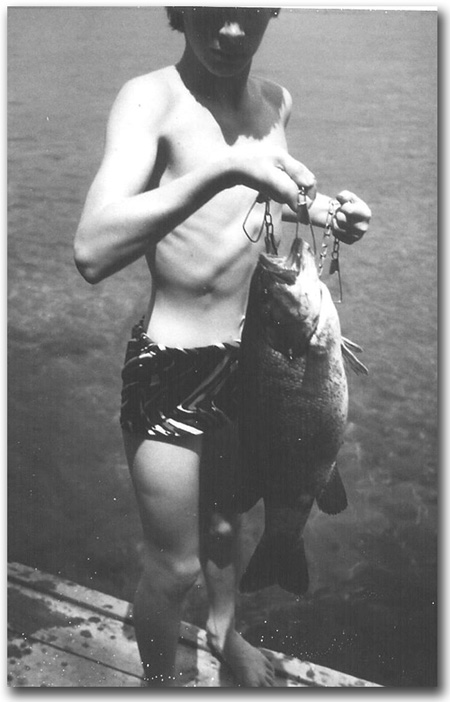 We have now developed this into an almost fool proof method, using either an anchor, or substituting a human diver for the anchor. The anchor, dragging on the bottom, dislodges rocks and crawfish, which attract the bass. And the commotion of the splashes also attracts, rather than scares the fish.
We have now developed this into an almost fool proof method, using either an anchor, or substituting a human diver for the anchor. The anchor, dragging on the bottom, dislodges rocks and crawfish, which attract the bass. And the commotion of the splashes also attracts, rather than scares the fish.
So our children became our "fish dogs" - excellent at holding a point and with great "noses" for bass! When we arrived at one of our secret spots, the kids, usually led by Laural, would dive into the water in mask, snorkel, and flippers and go hunting for bass, even before I could get the anchor out.
The children would swim off the rocks, diving down to 10 or 15 feet from time to time until they spotted a bass. They would then signal to us, how many and what size, using hand and arm signals, holding up 3 fingers for a 3-pounder.
Once they'd attracted and discovered the fish, they'd remain holding "on point" until I cast hellgrammites, crawfish or frogs. If a smaller bass beat the large one to the bait (not usual, as the dominant fish will usually attack the bait first), they would tell me so I would not let him swallow the bait and get hooked.
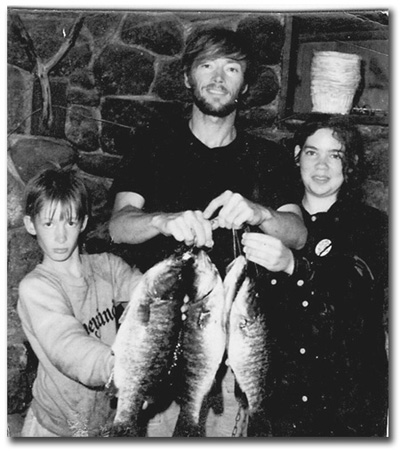

Once when I was tied to a 4-pounder, one of our children swam between the fish and a buoy, around which the fish was threatening to wrap my line, warding him off with outstretched hands and feet, every time he charged that way!
Years ago we had a city slicker guest, a flat-lander who had never fished before. We were using frogs instead of hellgrammites for bait, and he complained that his kept sinking. It was clear to me that his frog was obviously dead from his not so gentle casting.
"How do you keep your frog floating?" he asked.Without looking up at him from my fishing, I replied, "From time to time, you have to blow air into his mouth."
In my peripheral vision, I could see him wince. "How do you do it?" he asked, not wanting to appear as naïve as he was.
"You have to kinda French kiss him," I replied, trying not to smile and give the fun away. "Just thrust your tongue into his mouth and give a quick burst of air."
By now my kids were about to laugh and give my joke away. We all turned to watch him holding the frog up to his face, and we doubled over in laughter when he inserted his tongue into the dead frog's mouth. His eyes were closed and he had a painfully disgusted look on his face.
"I can't do this!" he cried.
It took him some time to forgive me from making him the butt of our fishing joke.
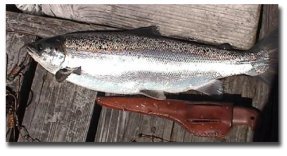
Landlocked Salmon
The landlocked Atlantic salmon is one of the most beautiful and spectacular fish in this New Hampshire lake. The name Salmo comes from the latin word salire meaning to leap, and leap it does, especially when hooked on a light line! It is known for its spectacular cartwheels, and high jumps when hooked near the surface, as it often is in the spring, when the salmon are pursuing smelt near the surface.
Of the Master Anglers in my book, the majority of them have listed the landlocked salmon as the fish they think is the best fighter. These silver fish are 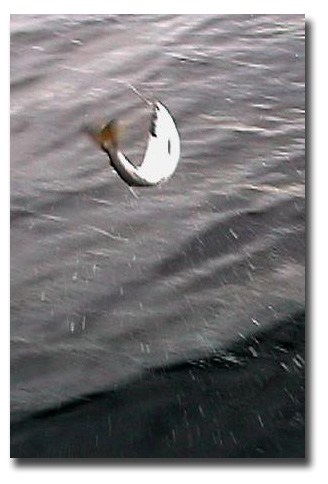 characterized by small black "x" pixel-like spots on their upper body.
characterized by small black "x" pixel-like spots on their upper body.
Though once an ocean-going fish, which migrated, into major rivers to spawn, landlocked salmon are now common in northeastern America and Canada. Originally there were plentiful runs of Atlantic salmon from the ocean up the Connecticut and Merrimack Rivers all the way through what is now the Pemigewasset River.
Jack Noon in a note to me states, "I have yet to find a verifiable account of them [salmon] in the Winnipesauke River," which leads to Lake Winnipesaukee. There are many tales in the 19th and 20th centuries including of the Abenaki Indians catching salmon by the thousands as they passed through the narrows at the Weirs, (an Indian name for fish trap).
Some say that the salmon stayed in the Lake when passage back to the sea became difficult, but that is not the case. "By 1847 dams outside of New Hampshire had completely blocked Atlantic Salmon from the state. Landlocked salmon, genetically identical to Atlantic salmon, were enthusiastically welcomed into New Hampshire because they were unaffected by dams, living their lives in lakes. They seemed to promise a simple solution to the complicated problem of salmon restoration."1 But simple it is not, as you will learn

I can remember catching landlocked salmon using hellgrammites with my uncle 64 years ago in Lake Winnipesaukee. They were first introduced into New Hampshire lakes in 1866. They were brought to Newfound Lake from the St. Croix River of New Brunswick and a year later they were stocked in Winnipesaukee, Squam and Sunapee Lakes.
Thirteen New Hampshire Lakes now have the Landlocked salmon.2 Salmon thrive in cold, clear, deep and well-oxygenated water. In the spring this means they will be found on the surface from just after ice-out until early June. This is a fly fisherman's delight! They thrive in 55° F water, but you will catch them wherever the smelt are.
The salmon spawn in the fall, beginning in early October and lasting through November. They approach the shore, guided from imprinted memories, seeking familiar swift streams where they travel up-current to gravel nesting sites near where they were spawned.
The female clears a bed with her tail while the waiting male wards off other competitors. When the female is ready to lay her eggs, she settles into her bed with the male beside her. They are modest creatures, spawning under the cover of darkness. "At the climax both fish open their mouths, stiffen their fins, and quiver, as the eggs fall to the bottom of the egg pit in a cloud of milt."3
The female then moves upstream and digs more gravel which washes down to cover the nest. Both parents-to-be then head back to the Lake, leaving the eggs to hatch on their own in early spring. The naturally spawned young will remain in the stream for two-three years before migrating to the Lake where they will grow fast.
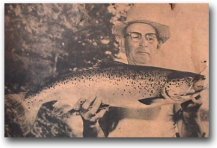
Stocked salmon grow even faster. When there is ample food, 6-7" stocked yearlings grow to an average of 18.8" by the end of their second year; 22.2" by the end of their third year; 23.2" by the end of their fourth year; 23.7" by fifth year; and 24" or larger by end of sixth year according to New Hampshire Fish and Game studies of netted salmon by big lakes biologist Don Miller using data from the fall spawning netting. But, all of this size data is dependent on the smelt population and the numbers of salmon to forage on the smelt.
The Delicate Balance Between Forage Fish and Salmon
The yearly size of our salmon varies, of course, depending upon the salmon's food source, which is mainly smelt supplemented by terrestrial insects such as hellgrammites. Salmon are very dependent upon a healthy smelt population.
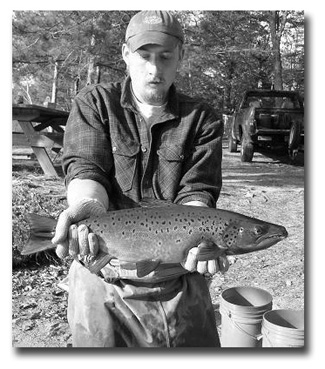
In 1988 and 1989 the New Hampshire Fish and Game overstocked salmon in Lake Winnipesaukee, given the small smelt population, stocking 45,000 salmon. I remember how elongated and thin the salmon were that next spring, looking almost as lean as pickerel. There was considerable concern expressed by fishermen.
Steps were taken to curtail commercial smelting in the Lake, by establishing a two-quart limit of smelt per day. Smelt eggs were purchased from Canada in an attempt to replenish the population.
Rick Davis, another of our Master Anglers, organized an effort back then to bring smelt eggs from Canada and the Great Lakes. However, the most effective solution was to cut back on the stocking to 16,000 in 1990, 20,000 in 1991, and later in the 1990s to between 24,000 to 27,000 yearlings per year.
This final number was based upon acoustic and electronic studies, as well as the size and health of the Salmon during the fall netting survey at Melvin Village, when the fish run up the river to spawn.
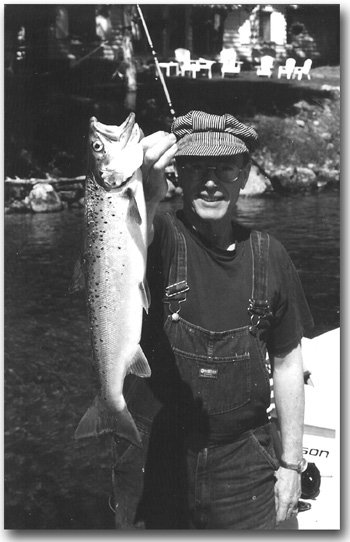 This reduction in numbers of salmon stocked the previous year, had a dramatic effect on salmon size the next spring. We became excited by 4 to 5-pound fish when 3-pounders were about as large as we were catching with hellgrammites a few years before.
This reduction in numbers of salmon stocked the previous year, had a dramatic effect on salmon size the next spring. We became excited by 4 to 5-pound fish when 3-pounders were about as large as we were catching with hellgrammites a few years before.
In 2002, we had one of those fertile years with large 20-24 inch salmon weighing 3.5 to 5 pounds being quite common. In 2003, many of us on the Lake Winni Angler site, found that we were catching mostly some very large salmon and lots of small ones with different bait including hellgrammites.
But we did not seem to be catching the most common fish -- those between 18-21".. This year, 2006, the salmon are fat and healthy, thanks to the great work by fish biologists and managers, Don Miller, John Viar, and their supervisor, Master Angler Steven Perry.
To order the complete award-winning book, Angling in the Smile of the Great Spirit, or its accompanying DVDs featuring live interviews with the Master Anglers of Lake Winni, please go to: www.deepwaterspress.com
- Noon, Fishing in New Hampshire -- A History, ibid, p. 102.
- Scarola, John F. Fresh Water Fishes of New Hampshire. New Hampshire Fish and Game Department, Division of Inland and Marine Fisheries, 1973. p. 26.
- Scarola.P. 28.